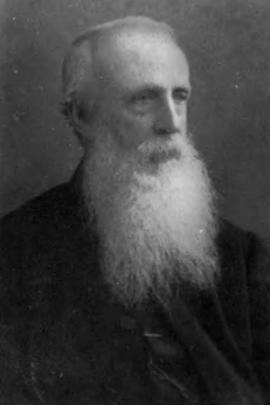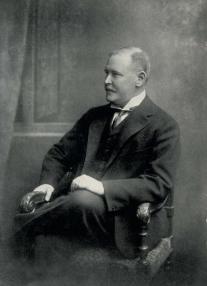Arthur Grote was an English colonial administrator. He entered the Bengal Civil Service in 1834, where as a civil servant he was employed in Bengal from 1834 to 1868 and was commissioner and member of the Board of Revenue, Calcutta, 1861-8. He also served as President of the Asiatic Society of Bengal, 1859-62 and 1865, and President of the Royal Agricultural Society of India. On his return to England in 1868 he became a prominent member of the Linnean Society of London and Royal Asiatic Society, and wrote many papers on natural history subjects
Andrew Dickson Murrary was a Scottish lawyer, botanist, zoologist and entomologist. Murray studied insects which caused crop damage, specialising in coleoptera. In botany, he specialised in Coniferae. He served as president of the Royal Physical Society of Edinburgh during 1858-59. Murray was a prominent opponent of the Darwin-Wallace model of natural selection. Murray believed that hybridisation was a better explanation for mimicry than natural selection. In 1860, Murray reviewed Darwin's On the Origin of Species in the Proceedings of the Royal Society of Edinburgh
Auguste Sallé was a French traveller and entomologist who specialised in Coleoptera. Following expeditions to the Southern States of the USA, the West Indies, Central America and Venezuela, Sallé returned to Paris to set up as a natural history and insect dealer
Professor Edward Hindle was a British biologist and entomologist who was Regius Professor of Zoology at the University of Glasgow from 1935 to 1943. He specialised in the study of parasites. He was founder of the Zoological Society of Glasgow. In 1943 he was appointed the first Scientific Director of the Zoological Society of London
Zakaria Erzinçlioğlu was a forensic entomologist. He used his expertise in insect biology in criminal investigations and solved more than 200 murders.
He was born in Hungary to parents of Turkish origin. He was brought up in Egypt, Sudan and England. He earned a degree in applied zoology from Wolverhampton Polytechnic in 1975, and then began working for the Zoological Society of London as Compiler for the Zoological Record. He then studied for his doctorate at Durham University. In 1984 he moved to Cambridge University where he wrote about blowflies for The Naturalists' Handbook series, as well as writing for other publications. He received funding to do research in forensic entomology and later was appointed director of a new Forensic Research Center at Durham University.
Octavius Pickard-Cambridge was an English clergyman and zoologist. His main interest was in spiders, though he wrote also on birds and lepidoptera. He published extensively on spiders between 1859 and his death in 1917, including in the the journal of the Zoological Society of London. He became a world authority of spiders, describing a considerable number of new species including the Costa Rican redleg tarantula and the Sydney funnel-web spider
Nathaniel Charles Rothschild was an English banker and entomologist and a member of the Rothschild family. He is remembered for The Rothschild List, a list he made in 1915 of 284 sites across Britain that he considered suitable for nature reserves. He devoted much of his energies to entomology and natural history collecting. His enormous collection of some 260,000 fleas in now in the Rothschild Collection at the Natural History Museum. He described about 500 new flea species
Southwood was a British biologist, Professor of Zoology and Vice-Chancellor of the University of Oxford. He was a specialist on entomology, he developed the field of insect ecology and the development of study techniques. He wrote a textbook on Ecological Methods. He was also well known for developing the field of entomology through mentorship of a circle of researchers at Silwood Park. He was employed in the Department of Zoology at the Institute of Animal Physiology and Genetics Research
Neave was a British naturalist and entomologist. He was the grandson of Sheffield Neave, a governor of the Bank of England and the father of Airey Neave. He was born in Kensworth, Hertfordshire, the son of Sheffield Henry M. Neave and his wife Gertrude Charlotte Margaret (nee Airey). He was educated at Eton and Magdalen College, Oxford.
Neave's first work was research into the problems related to the tsetse fly and the study of African animal life. He was part of the Geodetic Survey of Northern Rhodesia between 1904 and 1905. Between 1906 and 1908 he was part of the Katanga Sleeping Sickness Commission and then from 1909 to 1913 the Entomological Research Committee of Tropical Africa.
He returned to the United Kingdom in 1913 and was appointed Assistant Director of the Imperial Institute of Entomology, becoming Director from 1942-1946. He was appointed as an officer of the Order of the British Empire in 1933 and a companion of the Order of St. Michael and St. George in 1941. From 1918 until 1933 he was Honorary Secretary of the Royal Entomological Society and was then its President in 1934-1935.
In 1934 he had the idea to compile an updated index of all published generic and subgeneric names in zoology, an activity which occupied the period 1935-1939, and resulted in the publication of his (initially) four volume 'Nomenclator Zoologicus' in 1939-1940. He also oversaw the preparation of a fifth volume, published in 1950.
Neave was Secretary of the Zoological Society of London from 1942. He retired in 1946 but carried on as Honorary Secretary until 1952.
Naeve married twice, firstly to Dorothy Middleton and they had two sons and three daughters, the eldest was Airey Neave, later a Member of Parliament. Dorothy died in 1942 and Neave married a second time to Mary Hodges in London in 1946.
Harold Maxwell-Lefroy was an English entomologist. He served as a Professor of Entomology at Imperial College London and as the second Imperial Entomologist to India. He left India after the death of two of his children from insect-borne diseases. He worked on applied entomology and initiated experiments on the use of chemicals to control insects. A formula he developed was utilised to save Westminster Hall from destruction by wood-boring beetles, while others were used to control lice in the trenches during the First World War. The success of his chemicals led to increased demand and the founding of Rentokil, a company for insecticide production. Maxwell-Lefroy's students included Evelyn Cheesman who took up a position at the insect house in London Zoo from 1919. He was killed while experimenting on fumigants to control insects.



